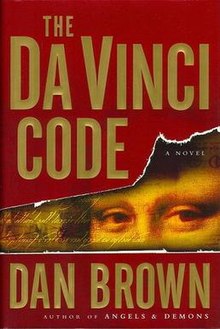
Back شيفرة دافنتشي (رواية) Arabic Da Vinçi şifrəsi AZ Код да Вінчы BE Шифърът на Леонардо Bulgarian দ্য দা ভিঞ্চি কোড (উপন্যাস) Bengali/Bangla Da Vincijev kod BS El codi Da Vinci Catalan کۆدەکەی دا ڤینچی CKB Šifra mistra Leonarda Czech Da Vinci Mysteriet Danish
 The first U.S. edition | |
| Author | Dan Brown |
|---|---|
| Series | Robert Langdon #2 |
| Genre | Mystery, detective fiction, conspiracy fiction, thriller |
| Publisher | Doubleday (US) |
Publication date | March 18, 2003[1] |
| Publication place | United States |
| Pages | 689 (U.S. hardback) 489 (U.S. paperback) |
| ISBN | 0-385-50420-9 (US) |
| OCLC | 50920659 |
| 813/.54 21 | |
| LC Class | PS3552.R685434 D3 2003 |
| Preceded by | Angels & Demons |
| Followed by | The Lost Symbol |
The Da Vinci Code is a 2003 mystery thriller novel by Dan Brown. It is Brown's second novel to include the character Robert Langdon: the first was his 2000 novel Angels & Demons. The Da Vinci Code follows symbologist Langdon and cryptologist Sophie Neveu after a murder in the Louvre Museum in Paris entangles them in a dispute between the Priory of Sion and Opus Dei over the possibility of Jesus and Mary Magdalene having had a child together.
The novel explores an alternative religious history, whose central plot point is that the Merovingian kings of France were descended from the bloodline of Jesus Christ and Mary Magdalene, ideas derived from Clive Prince's The Templar Revelation (1997) and books by Margaret Starbird. The book also refers to The Holy Blood and the Holy Grail (1982), although Brown stated that it was not used as research material.[2]
The Da Vinci Code provoked a popular interest in speculation concerning the Holy Grail legend and Mary Magdalene's role in the history of Christianity. The book has been extensively denounced by many Christian denominations as an attack on the Catholic Church, and also consistently criticized by scholars for its historical and scientific inaccuracies. The novel became a massive worldwide bestseller,[3] selling 80 million copies as of 2009[update],[4] and has been translated into 44 languages. In November 2004, Random House published a Special Illustrated Edition with 160 illustrations. In 2006, a film adaptation was released by Columbia Pictures.
- ^ "How Good Is Dan Brown's The Lost Symbol?". Time. September 15, 2009.
- ^ Suthersanen, Uma (June 2006). "Copyright in the Courts: The Da Vinci Code". WIPO Magazine. Retrieved June 12, 2024.
- ^ Wyat, Edward (November 4, 2005). "'Da Vinci Code' Losing Best-Seller Status" Archived October 12, 2013, at the Wayback Machine. The New York Times.
- ^ "New novel from Dan Brown due this fall". San Jose Mercury News. Archived from the original on June 4, 2011. Retrieved January 4, 2011.